Try Königsberger Klopse, a traditional East German dish, made of boiled meatballs in a white sauce with capers and anchovies. The creamy white sauce has a distinct savory yet tangy taste that makes this dish so popular.
I find it curious that this is known as a "classic German dish" because it originates from the town of Königsberg, which lies 7 hours drive beyond the German Border. The unique flavor combination of capers and anchovies is also not typical German food. In this post, I will tell you about the history and how to make these famous German meatballs in white sauce. (you can also jump straight to the recipe)
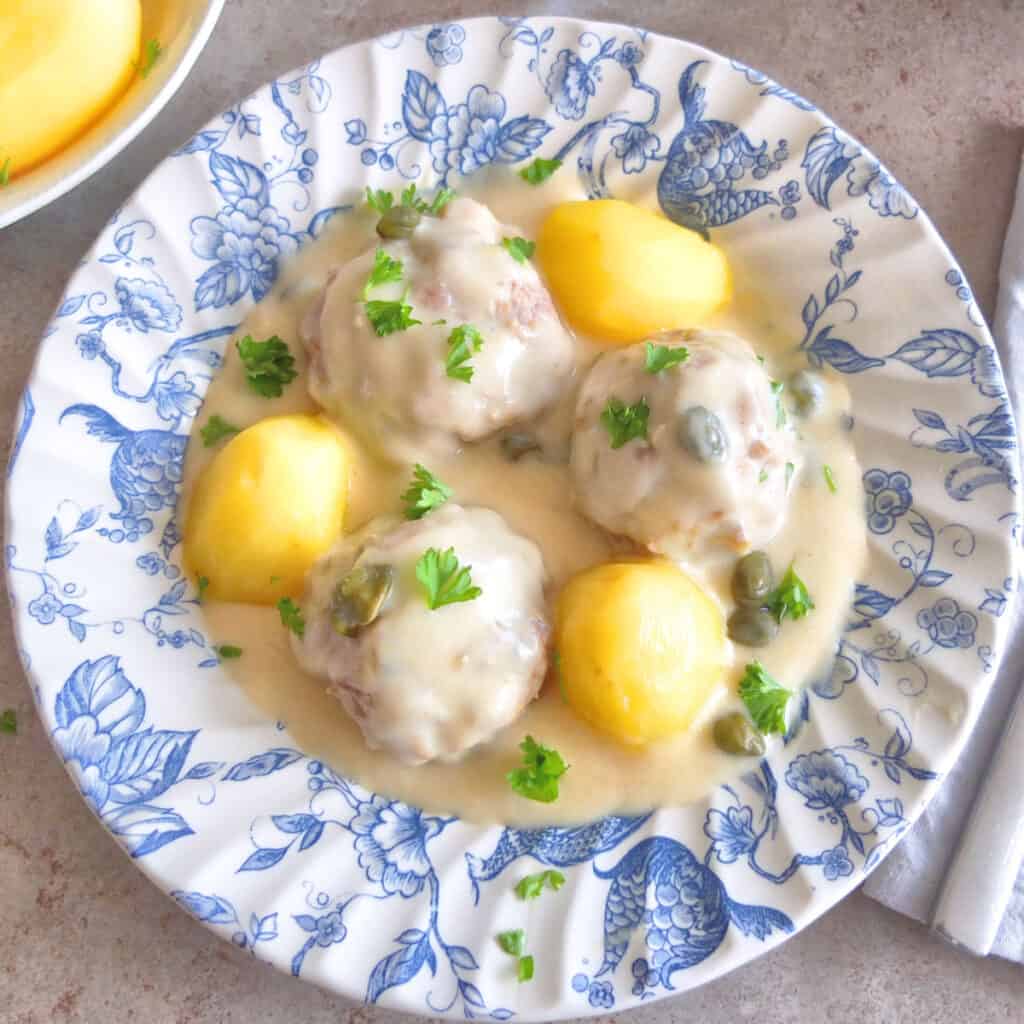
What is Königsberger Klopse?
Königsberger Klopse is a Prussian dish that is traditionally boiled veal meatballs with anchovies, served in a white sauce with capers. Colloquially they are known as “sour meatballs” as the addition of capers, anchovy, and lemon juice gives the dish a slightly tangy flavor.
The name for this dish is put together by two components. Königsberg (which is the town it originates from -more about the history further down) and Klopse. Klopse is the East German term for meatballs. There are several different meatball names in Germany- as you can read in my article about Frikadellen.
You will hear this dish referred to by different names in Germany. Other terms include
- Saure Klopse or Sauer Klopse (literally translated as sour meatballs)
- Kapernklopse (literally translated as caper meatballs)
- Soßklopse (literally translated as sauce meatballs)
But Königsberger Klöpse in English translates as meatballs from Konigsberg.
How to Pronounce Königsberger Klopse
Listen to this recording on how to pronounce the name in German
History
The history of the Königsberger Klopse had its origins in the 19th century. Königsberg is a town that today lies in Russia and is called Kaliningrad. Königsberg was the capital of East Prussia since 1724. It used to be an important trading port which explains why exotic ingredients such as anchovies and capers are used in this dish. [Wikipedia: Königsberg]
This regional Prussian delicacy gained popularity in Germany, as housemaids were sent from Prussia to Germany to work. The famous philosopher Immanuel Kant was also an admirer of these creamy German meatballs. He lived in Königsberg and served his numerous high-profile guests this Prussian dish. This is how Königsberger Klopse started to appear as a German delicacy in numerous cookbooks – and was now deemed acceptable for the upper classes.
The Konigsberg meatballs were at first reserved for the upper class. Two of the main ingredients, ground veal, and anchovies, were expensive. However, over time the veal was replaced with ground beef or ground pork (or a mixture of the two), and the anchovies were substituted with chopped herring. Soon two versions of this dish developed alongside another: one for the upper and another for the lower classes.
Today it is still one of the most popular regional dishes in Germany. According to a Forsa Survey in 2009, 93% of Germans knew of this dish.
How to make Königsberger Klopse
Let me show you how to make these German meatballs. It is very easy, but it does require a little time. So some reserve it for special occasions, or eat it at restaurants. But homemade they are best.
I have included step-by-step images for the visual learners under us. Jump straight to the printable recipe card to see the quantities.
Ingredients for the Meatballs
- onion
- ground pork and ground beef (alternatively ground veal)
- Stale buns (a crusty German-style roll is best, but you can also use leftover French bread).
- egg - to hold the meatballs together
- bread crumbs - these will make the meatballs fluffy while giving them stability
- lemon peel - for the unique tangy flavor
- anchovy fillets or anchovy paste. (optional- leave our if you don't like them)
- marjoram (affiliate link) (if not available you can substitute with sage (affiliate link))
For the broth
- beef broth/ stock
- spices: bay leaf and allspice, salt and pepper
- onion
For the white sauce
- butter, flour, and broth from the meatballs to create a roux
- sugar and lemon juice for flavouring
- cream (heavy cream or whipping cream will do)
- capers - to add this salty tanginess to the sauce.
Königsberger Klopse Recipe
Step One- Form the meatballs
- Soak the bread rolls in some warm water for approximately 15 minutes. Once soft, squeeze out all the liquid with the help of a colander or cheesecloth. This is important as you do not want your meatballs to become too soggy and fall apart.
- Chop the onion finely. Heat the butter in a frying pan and fry until translucent.
- In a large bowl, add the mince, bread pulp, egg, breadcrumbs, lemon peel, fried onions and, if you want, anchovy or anchovy paste. Combine to a smooth mass. Season with salt and pepper.
- From there form some meatballs. They must be all a similar size, so they cook evenly. You can either weigh them, one by one or proportion them with an ice cream scoop. Place them on a plate, cover them, and place them in the fridge until needed. (This will help them become a little firmer).
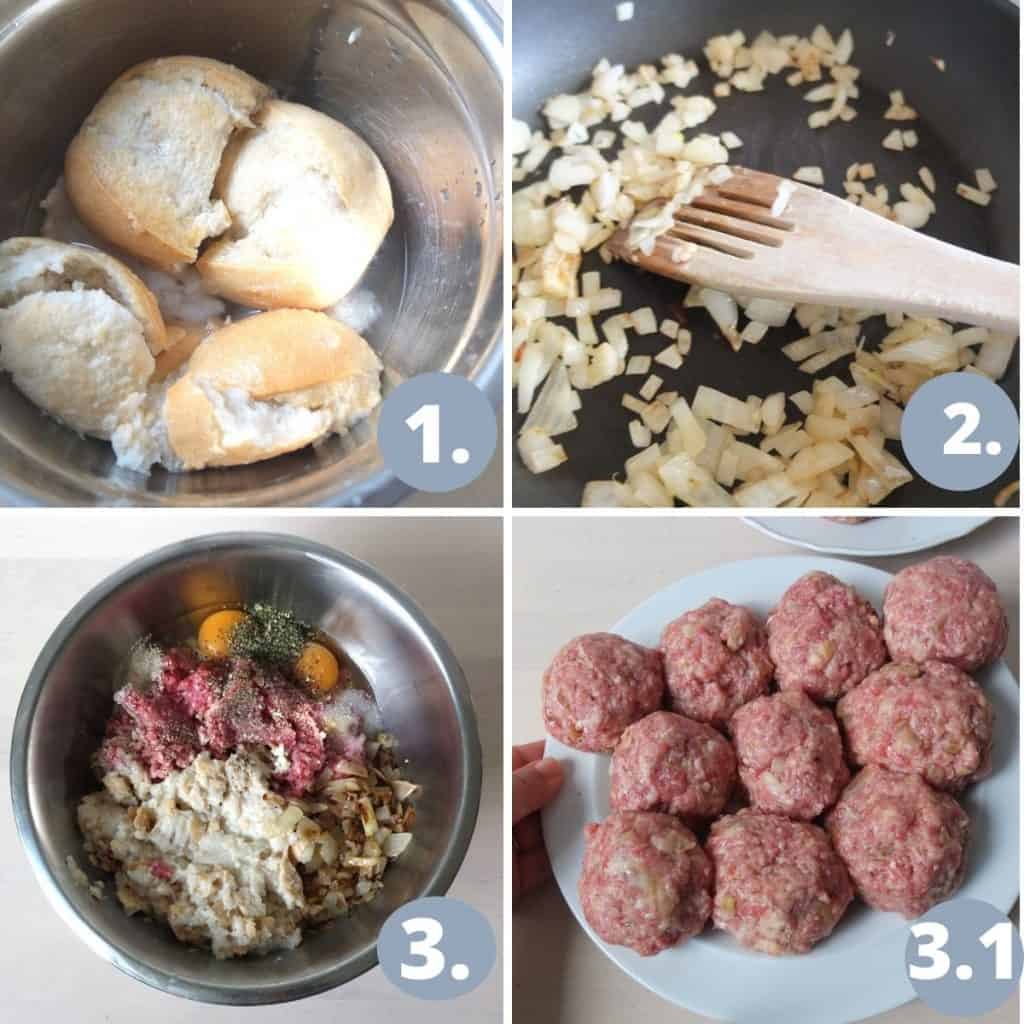
- Let’s start making the broth/stock. Place all ingredients in a large pot (at least 5 liters). Bring the broth/stock to a boil and then reduce the heat so it just simmers. Add the meatballs to the simmering water. (The water should not boil wildly).
- Leave to slowly cook for 15-20 minutes. Always check that the largest meatball is cooked through before removing all the meatballs from the broth. Fish out all the meatballs with a slotted spoon and place them on a plate. Measure off 400 ml of the broth and set aside.
Make the white caper sauce
- To make the sauce we will create a roux (Mehlschwitze in German). Melt the butter in the saucepan on medium-to-high heat.
- Add the flour and quickly mix it until it forms a smooth paste. Slowly pour a little of the broth into the pot. Mix with a whisk until all lumps disappear then repeat this step until all the broth has been used up.
- Reduce the heat of the stove, the sauce should no longer boil. Now add the drained capers and cream. Add lemon juice and season with some sugar, salt, and pepper to taste. Mix in the egg yolk to thicken the sauce.
- Pour the sauce over the meatballs. Serve with chopped parsley.
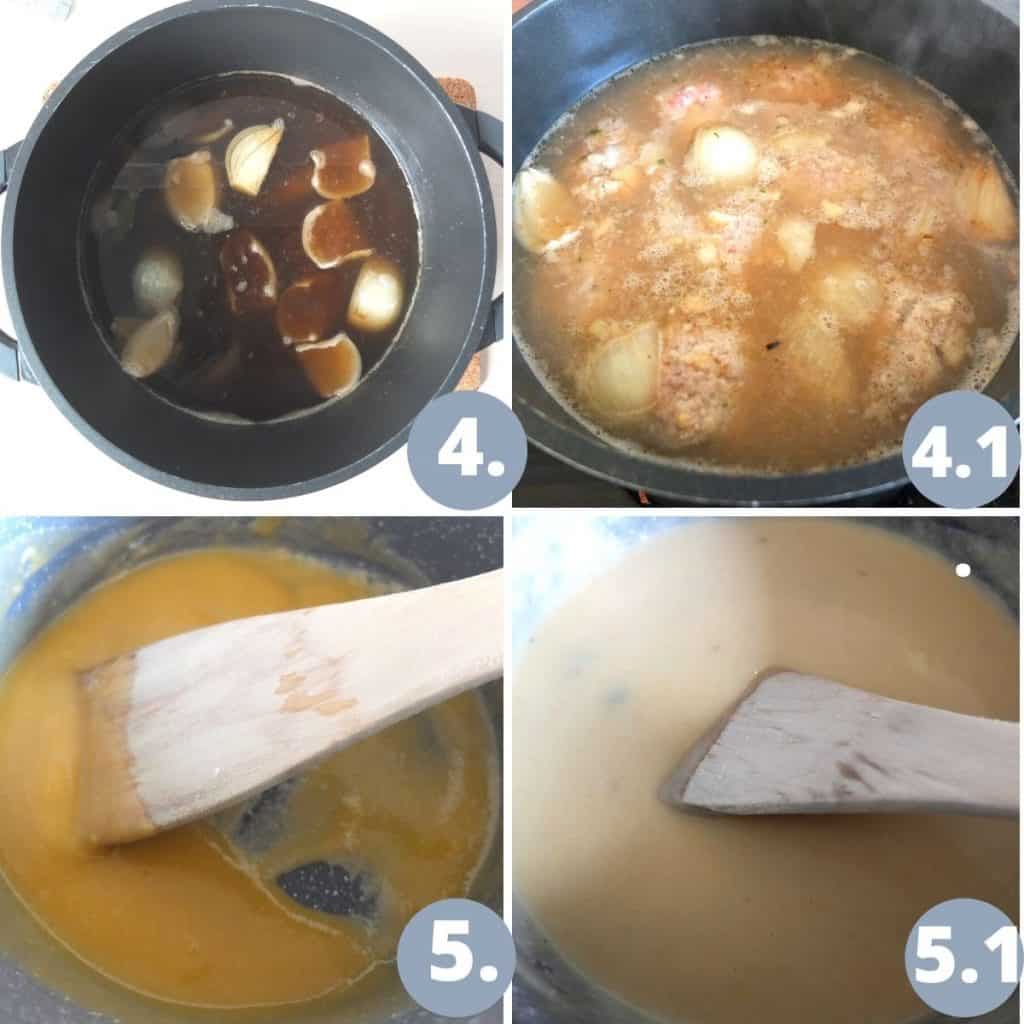
TIP: Do not discard the rest of the broth, as it works well as a base for a sauce. For example, you can use the stock for making German Potato Soup or Pea Soup.
Recipe Variations
- Koenigsberger Klopse without capers. (For those of you who do not like capers you can omit them, although you don’t get the same sour taste. Another idea is to secretly chop them up very finely and add them to the meatballs. Nobody will know but you!
- Replace some of the broth with dry white wine (about 120 ml / ½ a cup) for an especially rich sauce.
- Anchovies are optional. If you don’t like them just leave them out. But they make the dish so much better! Trust me!
- To make Vegan Konigsberger Klopse, you can replace the meat mince with a mix of smoked and natural tofu. Here is a link to a recipe (in German)
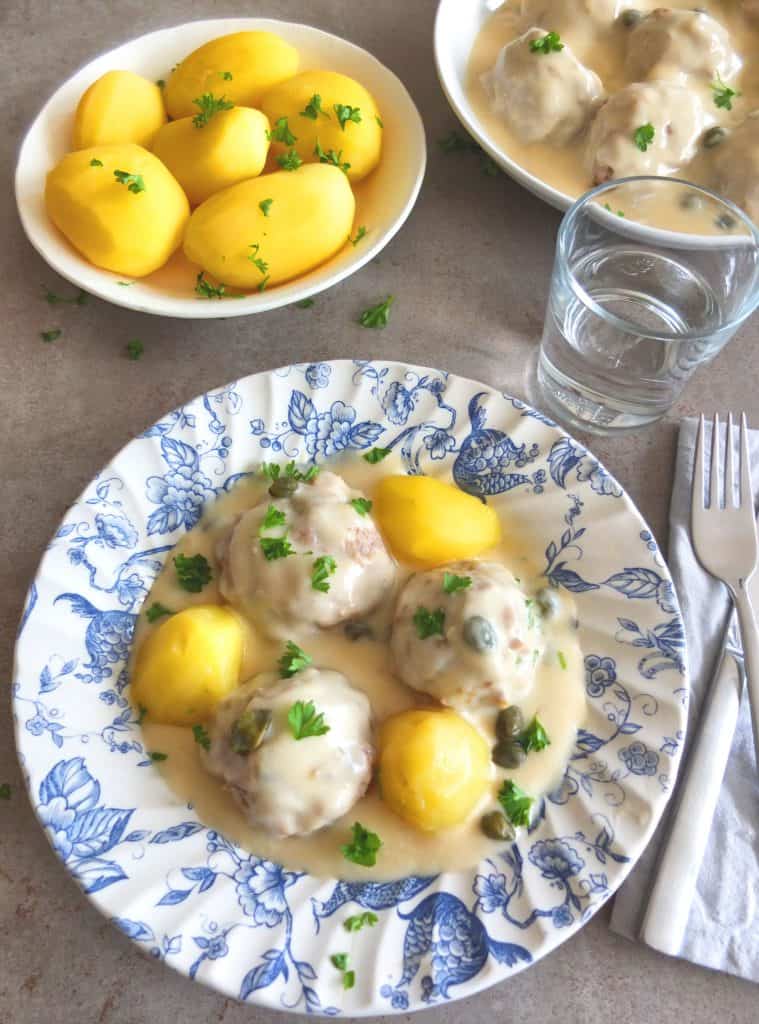
How to serve
In Germany, this dish is most commonly served with boiled ( Saltzkartoffeln) or Mashed Potatoes (Kartoffelbrei). However, they are also eaten with rice and pasta (which are similar to Tagliatelle).
Popular side dishes to Königsberger Klopse are also pickled Beetroot, Sauerkraut or German Red Cabbage. They go well with the sweet and sour taste of the dish.
A green salad also goes well with this rich dish. I would suggest this cucumber and radish salad or this German Beet Salad.
Storage Instructions
The Klopse (Meatballs) and sauce stay good in the fridge up to three days. Store in an airtight container.
If you want you can prepare the meatballs in bulk and then freeze them uncooked. However, you need to be aware that you should freeze the meatballs without delay. Warm ground beef and pork attract bacteria. First, freeze them individually, and then you can put them together in a freeze bag for storage. The uncooked meatballs will stay good up to three months.
You can also freeze the cooked meatballs in the sauce. Just store in an airtight container and they stay good for up to 6 months.
More Delicious German Main Courses
- Käsespätzle- German cheese spätzle
- German Beer Goulash
- Szegedin Goulash - Goulash with Sauserkraut
- Venison Goulash
- Wiener Schnitzel
- Turkey Schnitzel
- Chanterelle Pasta
Recipe
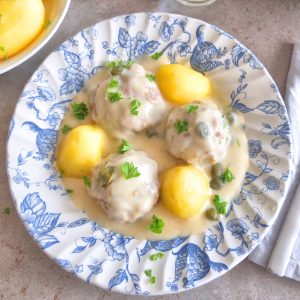
Authentic Königsberger Klopse (German meatballs in caper sauce)
Ingredients
For the Klopse / Meatballs
- 2 crusty rolls stale, best a day old. You can also use baguette or any other crusty white bread.
- 1 tablespoon butter
- 1 onion
- 250 g ground beef ½ lb/ 9 oz (can be substituted with ground veal)
- 250 g ground pork ½ lb/9z (can be subsituted with ground veal)
- 1 egg
- 3 tablespoon bread crumbs
- 2 teaspoon lemon peel
- 3 anchovies (optional) finley chopped. Alternativley use ½ teaspoon anchovie paste.
- 1 teaspoon marjoram if not available use sage (affiliate link)
For the broth/stock
- 1 litre beef broth/stock 4 cups
- 1 bay leaf
- ½ teaspoon all spice
- 1 onion quartered
For the caper sauce
- 3 tablespoon butter
- 2 tablespoon flour
- 1 pinch sugar
- 2 teaspoon lemon juice
- 350 ml from the meatball broth/stock 1 ½ cups
- 150 ml cream 0.5 cups , heavy or whipping cream
- 3 tablespoon capers
to serve
- 3 tablespoon parsley finley chopped
Instructions
To make the meatballs
- Soak the bread rolls in some warm water for approximately 15 minutes. Once soft, squeeze out all the liquid with the help of a colander or cheesecloth. This is important as you do not want your meatballs to become too soggy and fall apart.2 crusty rolls
- Chop the onion finely. Heat the butter in a frying pan and fry until translucent.1 onion, 1 tablespoon butter
- In a large bowl, add the ground meat, bread pulp, egg, breadcrumbs, lemon peel, marjoram (affiliate link), fried onions and, if you want, anchovy or anchovy paste. Combine to a smooth mass. Season with salt and pepper.250 g ground beef, 250 g ground pork, 1 egg, 3 tablespoon bread crumbs, 2 teaspoon lemon peel, 3 anchovies, 1 teaspoon marjoram (affiliate link)
- Now let’s start making the broth/stock. Place all ingredients in a large pot. Bring the broth/stock to a boil and then reduce the heat so it just simmers. Add the meatballs to the simmering water. (The water should simmer not boil wildly!). Leave to slowly cook for 15-20 minutes. Always check that the largest meatball is cooked through before removing all the meatballs from the broth. Remove all the meatballs with a slotted spoon and place on a plate. Measure off 350 ml/ 1 ½ cups of the broth and set aside.1 litre beef broth/stock, 1 bay leaf, ½ teaspoon all spice, 1 onion
Make the sauce
- To make the sauce, melt the butter in the saucepan. Add flour and mix until it forms a smooth paste. Slowly pour in the broth. Bring to boil for about 5 minutes. Remove the pot from the heat. Now add the drained capers and cream. Add lemon juice and season with some sugar and salt and pepper to taste.3 tablespoon butter, 2 tablespoon flour, 1 pinch sugar, 2 teaspoon lemon juice, 350 ml from the meatball broth/stock, 150 ml cream, 3 tablespoon capers
Assemble
- Pour the sauce over the meatballs. Serve with chopped parsley.3 tablespoon parsley
Notes
Variations
- without capers. (For those of you who do not like capers you can omit them, although you don’t get the same sour taste. Another idea is to secretly chop them up very finely and add them to the meatballs. Nobody will know but you!
- Replace some of the broth with dry white wine (about 120 ml / ½ a cup) for an especially rich sauce.
- Anchovies are optional. If you don’t like them just leave them out. But they make the dish so much better! Trust me!



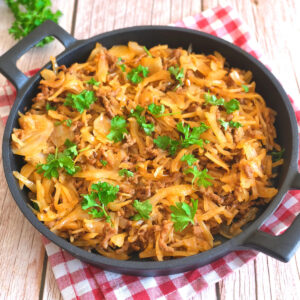
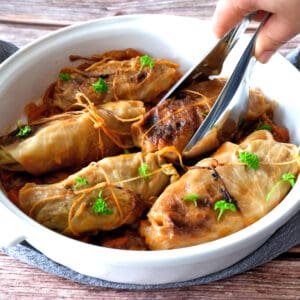

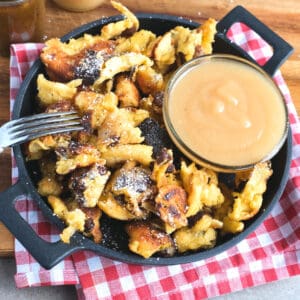
bob berkhout
I just harvested my garlic and couldn't resist adding a whole clove which I never did before. Best ever klopse!
Marita
Hi Bob, thanks so much for feedback! Adding garlic is a great idea!
Edeltraut Mc Bain
My granny Oma came from Königsberger and made the best Königsberger Klops. Thank you for the recipe I have never made them myself. I have now lived in Scotland for 40 years and miss a lot of the German food.
Marita
Hi Edeltraut,
thanks for your comment. I hope this recipe can bring back some memories of your Oma. Best Wishes Marita
Oksana
Outstanding! Well worth the effort and the family wants more ASAP.
Marita
Hi Oksana,
I am so glad your family enjoys this recipe.
Best Wishes
Marita
Mihaela|https://theworldisanoyster.com/
Whenever I travel, I am looking for local food and a taste of the cuisine of my visiting places. I feel I'm getting a culinary education from reading your posts that always explain the origin of a dish and a bit of local history. I will try to make my own meatballs Prussian style, but even better, I'm looking forward to serving it in a german restaurant on my next trip!
Marita
Thank you Mihaela, I hope you get to try them soon. May it be in a German Restaurant or at home.
Patrice
I remember eating something similar to this when I was in Germany. Will have to try your recipe. Love the plates too!
Nora
So delicious! I love Königsberger Klopse! Thank you for sharing your recipe!
Gina
I traveled to Germany a few years ago and loved the food! This looks so delicious!
Marita
Thanks, I hope you get to try this.